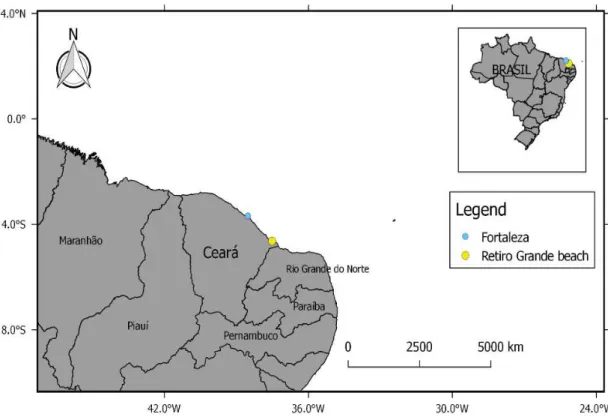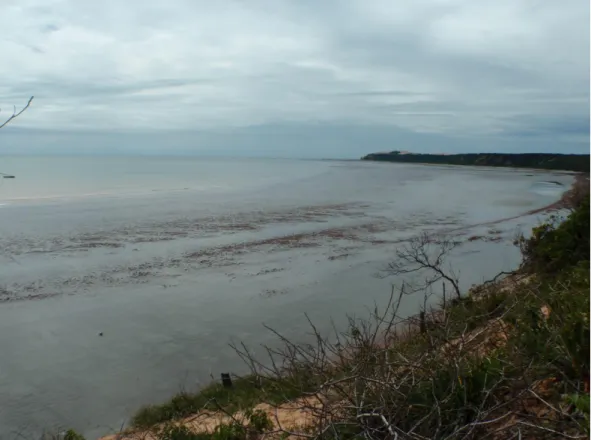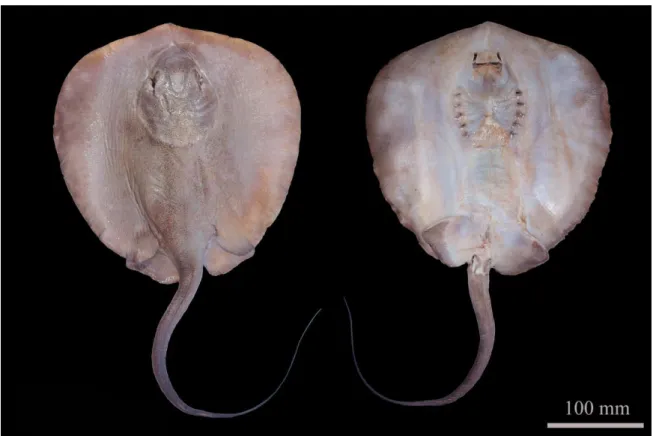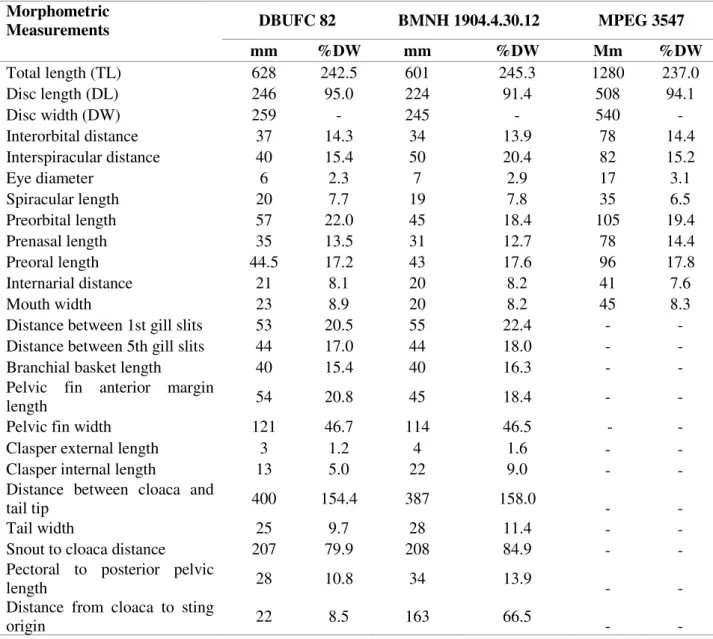UNIVERSIDADE FEDERAL DO CEARÁ
INSTITUTO DE CIÊNCIAS DO MAR – LABOMAR
CURSO DE OCEANOGRAFIA
MANUELA ALVES NOBRE SALES
LIMITE AO SUL DA DISTRIBUIÇÃO DA RAIA REDONDA, Styracura schmardae (POTAMOTRYGONIDAE)
FORTALEZA
MANUELA ALVES NOBRE SALES
LIMITE AO SUL DA DISTRIBUIÇÃO DA RAIA REDONDA, Styracura schmardae (POTAMOTRYGONIDAE)
Trabalho de Conclusão de Curso apresentado ao curso de Bacharelado em Oceanografia do Instituto de Ciências do Mar da Universidade Federal do Ceará.
Orientador: Prof. Dr. Vicente Vieira Faria Coorientador: Dr. João Eduardo Pereira de Freitas
FORTALEZA
MANUELA ALVES NOBRE SALES
LIMITE AO SUL DA DISTRIBUIÇÃO DA RAIA REDONDA, Styracura schmardae (POTAMOTRYGONIDAE)
Trabalho de Conclusão de Curso apresentado ao curso de Bacharelado em Oceanografia do Instituto de Ciências do Mar da Universidade Federal do Ceará.
BANCA EXAMINADORA
________________________________________ Prof. Dr. Vicente Vieira Faria (Orientador)
Departamento de Biologia, Universidade Federal do Ceará - UFC
_________________________________________
Prof. Dr. Manuel Antonio de Andrade Furtado Neto
Departamento de Engenharia de Pesca, Universidade Federal do Ceará - UFC
_________________________________________
Profa. Dra. Caroline Vieira Feitosa
AGRADECIMENTOS
Ao prof. Dr. Vicente Faria por todo o apoio, orientação e pelo aprendizado diário nesses anos de formação.
Ao Dr. João Eduardo Pereira de Freitas por toda a ajuda na análise do material e coorientação.
Ao prof. MSc. Carlos Costa Cavalcante pela disponibilização do espécime de Styracura schmardae e todo apoio, tornando este trabalho possível.
À Dra Patricia do Nascimento Bordallo por abrir as portas do Laboratório de Biologia Molecular da Embrapa Agroindústria Tropical para a realização de parte da presente pesquisa.
Ao prof. Dr. Jones Santander-Neto pelos comentários e sugestões nas versões iniciais deste manuscrito.
Aos membros da banca examinadora pela disponibilidade e pelas contribuições. À todos os professores da UFC, da Humboldt State University e da Florida Atlantic University que contribuíram para minha formação profissional.
À Débora Moraes e Ana Beatriz Leite, graduandas do curso de oceanografia e bolsistas do PET, por me ajudarem com os mapas através dos vídeos tutoriais de QGIS.
As minhas queridas amigas, em especial, Amanda Gadelha, Camena Costa, Iohana Melo e Jaqueline Moraes, e a meu amigo Gustavo Aracena, por todo o apoio e paciência.
Aos meus amados pais, Francisco Evaldo e Noélia Alves, e meus irmãos, Amanda Alves e João Eduardo Nobre. Eles me deram todo o amor e compreensão e confiaram nas minhas decisões, sempre contribuindo para os meus estudos e minha vida.
Por fim, aos meus animais de estimação, Summer, Shmoo, Bartolomeu e Judith, por serem minha alegria diária e por passarem as madrugadas me dando apoio. Eles foram verdadeiros companheiros.
RESUMO
O conhecimento da faixa de distribuição geográfica de uma espécie é importante para a compreensão de sua tolerância e necessidades ambientais. Este conhecimento também é importante para o desenvolvimento de estratégias de conservação espécie-específica. Uma das espécies de elasmobrânquios que ainda não tem a sua faixa de distribuição completamente conhecida é a raia redonda, Styracura schmardae (até recentemente conhecida como Himantura schmardae). Além disso, esta espécie é considerada ‘Deficiente em Dados’ pela União Internacional para a Conservação da Natureza (IUCN). Dentro desse contexto, o presente estudo teve como objetivo estabelecer o limite sul da faixa de distribuição geográfica de S. schmardae. Isto foi feito a partir de um espécime amostrado na costa de Icapuí, Ceará, Brasil, capturado por uma rede de arrasto (picaré). Várias características morfológicas do exemplar são diagnósticas da espécie Styracura schmardae. Além disto, a sequência de DNA do gene mitocondrial NADH do exemplar teve 99% de similaridade com sequencias homólogas de S. schmardade disponíves no Genbank após análise do tipo BLAST. O espécime foi depositado na Coleção Ictiológica do Departamento de Biologia da Universidade Federal do Ceará (DBUFC 82). Este é o primeiro registro confirmado de S. schmardae no sudoeste do Oceano Atlântico.
ABSTRACT
Knowledge about a species distribution range is important for understanding its environmental tolerance and needs. This knowledge is also relevant for the development of species-specific conservation strategies. One elasmobranch species that still does not have its distribution range well known is the Caribbean whiptail stingray Styracura schmardae (until recently known as Himantura schmardae). Moreover, this species is considered ‘Data Deficient’ by the International Union for the Conservation of Nature (IUCN). It is within this context that the present study had the goal of establishing the southernmost distribution range limit for S. schmardae. This was done based on one specimen caught on the coast of Icapuí, Ceará, Brazil, using beach seine net. Several morphological features of the specimen are diagnostic for S. schmardae. In addition, a sequence of the mitochondrial DNA gene NADH-2 obtained for this specimen was 99% similar to S. schmardae homologous sequences available on GenBank after BLAST analyses. The specimen was deposited at the Ichthyological Collection at Department of Biology at the Federal University of Ceará (DBUFC 82). This is the first confirmed record of S. schmardade in the southwest Atlantic.
LISTA DE FIGURAS
Figure 1 - Capture location forthe Caribbean whiptail stingray, Map showing the capture area of the Styracura schmardae, Retiro Grande Beach (Yellow dot), Icapuí, Ceará, Brazil. Source: author.
11
Figure 2 - The samplig site: Retiro Grande beach, Icapuí, easternmost Ceará, Brazil. Source: Carlos Cavalcante.
12
Figure 3 - The specimen of the Caribbean whiptail stingray, Styracura schmardae, during its capture at Icapuí, easternmost Ceará State, Brazil. Source: Carlos Cavalcante.
12
Figure 4 - The specimen of the Caribbean whiptail stingray, Styracura schmardae, captured at the limit of it distribution range in the southwest Atlantic. This specimen is now deposited at the ichthyological collection at Department of Biology at the Federal University of Ceará (DBUFC 82). Source: Author.
14
Figure 5 - Distribution range for the Caribbean whiptail stingray, Styracura schmardae. Colors indicate the range agreeing with the cited article:In yellow, the area of capture of the specimen of this study; In red, an addition of the distribution of S. schmardae proposed by Almeida et al (2008);.In Green, the addition of the distribution of S. schmardae
porposed by O’Shea et al. (2017); In orange, it is the distribution range of the specie known by the International Union for the Conservation of Nature (IUCN).
SUMMARY
1 INTRODUCTION ... 11
2 MATERIAL AND METHODS... 12
2.1 Study area... 12
2.2 Morphological identification... 14
2.3 Molecular identification... 14
3 RESULTS ... 14
4 DISCUSSION... 17
5 CONCLUSION... 19
12
1. INTRODUCTION
Knowledge about distribution range is important for understanding a species tolerance and needs, as well as for the development of conservation strategies (BROWN and LOMOLINO, 1998). One species of Elasmobranchii that does not have its distribution range well studied is the Caribbean whiptail stingray Styracura schmardae (Werner, 1904). This was species is more commonly known as Himantura schmardae (Werner, 1904), belonging to the family Dasyatidae. Nevertheless, morphological and molecular evidence has shown that this species is, in fact, too much divergent from other Himantura species (LOVEJOY et al. 1998; COMPAGNO 1999; NAYLOR et al. 2012; LAST et al. 2016). As a result, this species was recently placed in a new genus (Styracura) and in a new subfamily (Styracurinae) (DE CARVALHO et al., 2016). Some of the morphological distinctive features of this species are: a rounded to weakly rhomboidal disk with a snout barely projected; a dorsal and anterior part of the tail covered with small tubercles; and the presence of a pair of dorsal scapular tubercles situated in the middle part of the disc laterally to the spine (STEHMANN et al., 1978; DE CARVALHO, 2016; DE CARVALHO et al., 2016).
The Caribbean whiptail stingray, S. schmardae, is considered ‘Data Deficient’ by the International Union for the Conservation of Nature (IUCN). This is, at least in part, due to the incomplete knowledge about of its distribution range (CHARVET-ALMEIDA & ALMEIDA, 2006). This species inhabits marine and estuarine environments with sandy or muddy bottoms in the western Atlantic (STEHMANN et al., 1978). Until recently, its distribution range was considered to extend from southern Mexico to northern Brazil (CHARVET-ALMEIDA & ALMEIDA, 2006; ALMEIDA et al., 2008). Nevertheless, this species northernmost range is now known to include The Bahamas (O’SHEA et al. 2017). As for its southernmost limit, there is an unconfirmed record for this species in Ceará, northeastern Brazil. This unconfirmed record
13
2. MATERIAL AND METHODS
2.1. Study area and sampling
Retiro Grande beach is located in Icapuí municipality, on the easternmost portion of Ceará State, Brazil, close to the border with Rio Grande do Norte State (Fig. 1). This beach is characterized by a sandy substrate and a low transparency of the water, probably because becomes clayey towards the west (Fig. 2). The specimen was captured at low tide on June 24, 2013, using a 1,0 m x 2,2 m beach seine (12 mm mesh size) deployed to a maximum depth of 1 m, in parallel and 50 m distant from the coast (Fig 3), at the 4º 38’30.63’’S 37º 31’55.30’’
W mark.
14
Fig. 2. The samplig site:Retiro Grande beach, Icapuí, easternmost Ceará, Brazil. Source: Carlos Cavalcante.
15
2.2. Morphological identification
In laboratory, the specimen was identified based on diagnostic morphological characters proposed by Stehmann, McEachran & Vergara (1978). Then, morphometric measurements were taken following Carvalho et al. (2016). In addition, the following data were recorded: (1) total body mass (using a digital scale), (2) gender, and (3) clasper rigidity. The specimen was then deposited at the Ichthyological Collection from the Department of Biology of the Federal University of Ceará (UFC) (DBUFC 82).
2.3. Molecular identification
A sample of muscle tissue was obtained from the specimen. The sample was deposited at the tissue sample collection of the Laboratory of Evolution and Conservation of Marine Vertebrates (EvolVe) at the Department of Biology (UFC) (FAR 324). Part of the sample was then used for DNA extraction. The total cell DNA was extracted with the DNeasy Blood & Tissue Kits, following manufacturer’s instructions (QIAGEN Inc., Valencia, CA, USA). Quality of the extracted DNA was assessed using the spectrophotometer NanoDrop 2000.
The extracted DNA was used for polymerase chain reaction (PCR) amplifications of the mitochondrial DNA gene NADH-2. The reactions were performed using the primers
Ilem-Mustelus 5' AAGGACCACTTTGATAGAGT 3' and Asn-Mustelus 5'
AACGCTTAGCTGTTAATTAA 3' (Naylor et al. 2012). The PCR reactions were made in a total volume of 25 μl, containing 50 ng of DNA, 1XAmpliTaq Gold 360 Master Mix (Life Technologies, Paisley, UK) and 0,5 μM of primer’s final concentration. The cycle reaction was as follows: initial denaturation of 94° C for 2 minutes; 39 cycles of denaturation at 95° C for 30 seconds, primer annealing at 48° C for 30 seconds, and extension at 72° C for 90 seconds; with final extension at 72° C per 7 minutes. The PCR reactions were performed using a Veriti 96-Well thermal cycler (Applied Biotech, Inc.).
16
products were then purified using ExoSAP-IT (Affymetrix, Inc.) following the manufacturer’s
guidelines. The purified PCR product was then sent to Macrogen Inc. (Seoul, South Korea) where were sequenced using capillary sequencer (EZ-Seq service; www.macrogen.com). In addition to the forward and reverse primers, one internal primer was also used for sequencing: ND2-batoids-IFA 5' CACTTYTGACTWCCAGAAGT -3' (Naylor et al. 2012)
The DNA sequences obtained were edited and aligned using the program Geneious 7.1.5. The full NADH-2 sequence was delimited using the mitochondrial genome of Styracura schmardae (GenBank – JN184062.1) as a model. The obtained 1,046bp NADH-2 gene sequence was then compared with two sequences of S. schmardae (GenBank -
JN184062.1; JQ519155) through BLAST
17
RESULTS
The specimen of ray was identified as belonging to the species Styracura schmardae based on the following diagnostic characters: (1) rounded rhomboid disk with rounded edges; (2) snout barely projected as a broad-based papilla; (2) anterior margin of the disc large and transverse to the body axis; (3) dorsal and anterior part of the tail covered with small tubercles; (4) dorsum dark brown to greenish; (5) presence of a pair of dorsal scapular tubercles situated in the middle part of the disc, laterally to the spine (typical of juveniles; adults have two or more pairs); (6) ventral coloration whitish to yellowish; (7) absence of caudal fins and dorsal fins; and (8) each side of the tail with a low longitudinal ridge running along anterior ¼ of the tail. The disc length was 258 mm and total body mass was 790g (Table 1). The specimen was an immature male with non-calcified claspers (Fig. 4).
Fig. 4. The specimen of the Caribbean whiptail stingray, Styracura schmardae, captured at the limit of it distribution range in the soputhwest Atlantic. This specimen is now deposited at the ichthyological collection at
18
Table 1. Morphometric measurements of the Caribbean whiptail stingray, Styracura schmardae, specimen
(DBUFC 82) captured at Icapuí, Ceará state, northeastern Brazil, Southwest Atlantic. Morphometrics of the specimens; BMNH 1904.04.30.12, described by Carvalho et al. (2016) and stored at the British Museum of
Natural History, and MPEG 3547,described by Almeida et al. (2008) stored at the Museum Paraense Emílio
Goeldi, is provided for comparison purposes.
The full NADH-2 sequence obtained from the S. schmardae specimen (DBUFC 82)
showed high percent identity with the two DNA sequences available in GenBank for its respective species (JN184062.1 and JQ519155). The BLAST outputs for both comparisons reached a value of 99% percent identity.
Morphometric
Measurements DBUFC 82 BMNH 1904.4.30.12 MPEG 3547
mm %DW mm %DW Mm %DW
Total length (TL) 628 242.5 601 245.3 1280 237.0
Disc length (DL) 246 95.0 224 91.4 508 94.1
Disc width (DW) 259 - 245 - 540 -
Interorbital distance 37 14.3 34 13.9 78 14.4
Interspiracular distance 40 15.4 50 20.4 82 15.2
Eye diameter 6 2.3 7 2.9 17 3.1
Spiracular length 20 7.7 19 7.8 35 6.5
Preorbital length 57 22.0 45 18.4 105 19.4
Prenasal length 35 13.5 31 12.7 78 14.4
Preoral length 44.5 17.2 43 17.6 96 17.8
Internarial distance 21 8.1 20 8.2 41 7.6
Mouth width 23 8.9 20 8.2 45 8.3
Distance between 1st gill slits 53 20.5 55 22.4 - - Distance between 5th gill slits 44 17.0 44 18.0 - -
Branchial basket length 40 15.4 40 16.3 - -
Pelvic fin anterior margin
length 54 20.8 45 18.4 - -
Pelvic fin width 121 46.7 114 46.5 - -
Clasper external length 3 1.2 4 1.6 - -
Clasper internal length 13 5.0 22 9.0 - -
Distance between cloaca and
tail tip 400 154.4 387 158.0 - -
Tail width 25 9.7 28 11.4 - -
Snout to cloaca distance 207 79.9 208 84.9 - - Pectoral to posterior pelvic
length 28 10.8 34 13.9 - -
Distance from cloaca to sting
20
3. DISCUSSION
The Caribbean whiptail stingray, Styracura schmardae, has its distribution range in the Southwest Atlantic. This was provisionally postulated by Jucá-Queiroz et al. (2008) and is now confirmed. Before the present study, the southernmost confirmed record for this species was the northern coast of Brazil, between Amapá and Pará; (ALMEIDA et al. 2008). The record of S. schmardae on the easternmost portion of Ceará, northeastern Brazil, extends the species’ known southernmost limit for 1,500 km. In addition, According to Garcia Jr. et al (2015), the species is not considered part of the marine fish fauna of the east-neighbouring state of Rio Grande do Norte.
Fig.5.: Distribution range for the Caribbean whiptail stingray, Styracura schmardae. Colors indicate the range agreeing with the cited article:In yellow, the area of capture of the specimen of this study; In red, an addition of the distribution of S. schmardae proposed by Almeida et al (2008);.In Green, the addition of the distribution of S. schmardae porposed by O’Shea et al. (2017); In orange, it is the distribution range of the specie known by the International Union for the Conservation of Nature (IUCN).
21
nearly all morphometric characters are practically the same as of those from Almeida et al. (2008), a S. schmardae specimen from the northern coast of Brazil. Finally, the DNA sequence high match to the reference sequence available from GenBank is also reassuring about the species identity.
22
4. CONCLUSION
23
REFERENCES
ALMEIDA, M. P.; CHARVET-ALMEIDA, P.; RINCON, G.; BARTHEM, R. Registro de ocorrência de Himantura schmardae (Chondrichthyes: Dasyatidae) na costa Norte do Brasil. Arquivos de Ciências do Mar, v. 41, n.2, p. 90-94, 2008.
ALTSCHUL, S. F.; GISH, W.; MILLER, W.; MYERS, E. W.; LIPMAN, D. J. Basic local alignment search tool. J. Mol. Biol., v. 215, p. 403-410, 1990.
BIGELOW, H. B.; SCHOEDER, W. C. Fishes of the Western North Atlantic. Part two: sawfishes, skates and rays. Mem. Sears Found. Mar. Res, v.2, p.1-588, 1953.
BROWN, James H.; LOMOLINO, Mark V. Biogeography. 2nd Edition. Sunderland: Sinauer Associates, 1998. 560p.
CHARVET-ALMEIDA, P.; DE ALMEIDA, M. P. 2006. Himantura schmardae. The IUCN Red List of Threatened Species. Version 2014.2. <www.iucnredlist.org>. Downloaded on 25 August 2014.
COMPAGNO, L.J.V. Checklist of living elasmobranchs. In: HAMLETT, W.C. (Ed.) Sharks, skates, and rays: the biology of elasmobranch fishes. John Hopkins University Press, Maryland, 1999. p. 471-498.
DE CARVALHO, M. R. Neotropical Stingrays: Family Potamotrygonidae. In: LAST, P.R., WHITE, W.T.; DE CARVALHO, M. R.; SÉRET, B.; STEHMANN, M.F.W.; NAYLOR, G. J. P. Rays of the World. Austrália: CSIRO, 2016. p. 619-655.
24
GARCIA-JÚNIOR, J.; NÓBREGA, M. F.; OLIVEIRA, J. E. L. Coastal fishes of Rio Grande do Norte, northeastern Brazil, with new records. Checklist, v. 11(3): 1659, 2015.
JUCÁ-QUEIROZ, B.; SANTANDER-NETO, J.; MEDEIROS, R. S.; NASCIMENTO, F. C. P.; FURTADO-NETO, A. A.; FARIA, V. V.; RINCON, G. Cartilaginous fishes (class Chondrichthyes) off Ceará State, Brazil, Western equatorial Atlantic – An update. Arquivos de Ciências do Mar, v. 41(2), p.73-81, 2008.
KYNE, P. M. Ray Conservation. In: LAST, P.R., WHITE, W.T.; DE CARVALHO, M. R.; SÉRET, B.; STEHMANN, M.F.W.; NAYLOR, G. J. P. Rays of the World. Austrália: CSIRO, 2016. p. 21-24.
LAST, P. R.; NAYLOR, G. J. P.; MANJAJI-MATSUMOTO, B. M. A revised classification of the family Dasyatidae (Chondrichthyes: Myliobatiformes) based on new morphological and molecular insights. Zootaxa, v. 4139, n. 3, p. 345-368, 2016.
LOVEJOY, N. R.; BERMINGHAM, E.; MARTIN, A. P. Marine incursion into South America. Nature, v. 396, n.6710, p.421-422, 1998.
NAYLOR, G. J. P.; CAIRA, J.; JENSEN, K.; ROSANA, K. A.;WHITE, W.;LAST, P. A DNA sequence–based approach to the identification of shark and ray species and its implications for global elasmobranch diversity and parasitology. Bulletin Of The American Museum Of Natural History, v. 367, p. 262, 2012.
25
O’SHEA, O. R. O.; WARD, C. R. E.; BROOKS, E. J. Range Extension in Styracura (=Himantura) schmardae (Caribbean Whiptail Stingray) from The Bahamas. Caribbean Naturalist, v. 38, p. 1–8, 2017.
STEHMANN, M., McEACHRAN, J. D., & VERGARA, R.R. Dasyatidae. In W. Fischer (ed.) FAO species identification sheets for fishery purposes. Western Central Atlantic (Fishing Area 31). Vol. 1., FAO, Rome, pp. DasyHimant 1, 1978.



